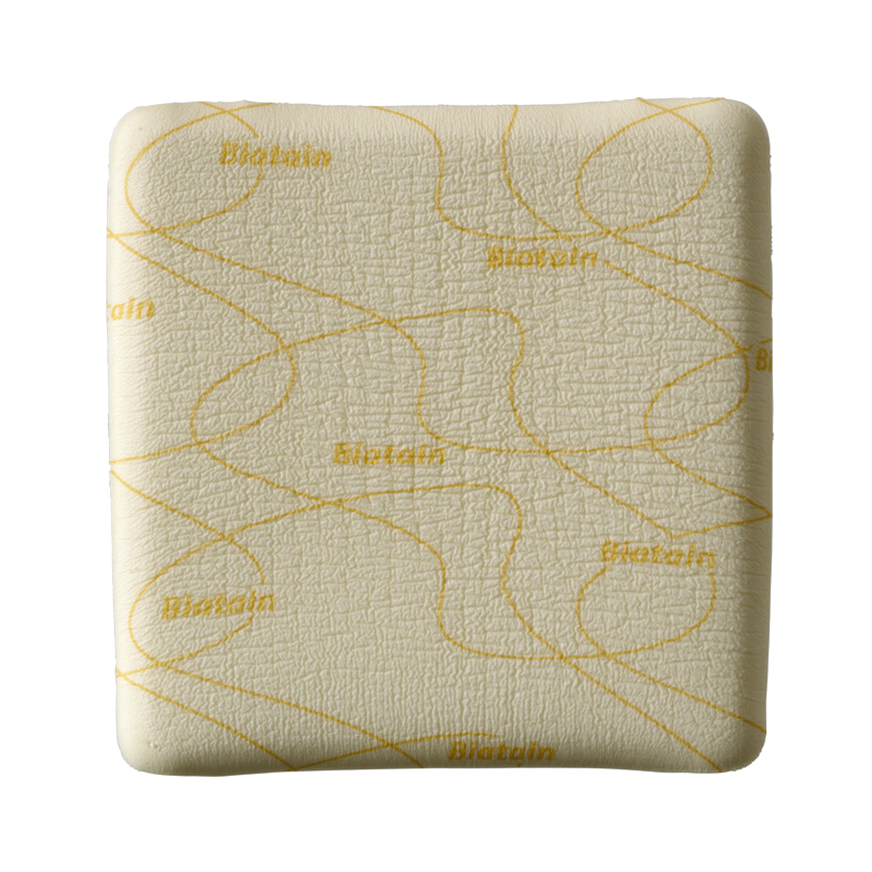Product description
Unique 3D foam structure for superior absorption
When in contact with exudate the unique 3D foam structure of Biatain® conforms closely to the wound bed for superior absorption – even under compression (1-3).
Minimised risk of maceration and leakage (1)
The superior absorption and retention of exudate minimises risk of maceration and leakage. This non-adhesive dressing is well suited for use on wounds with very fragile periwound skin.
Long wear time
Due to the superior absorption capacity of Biatain® the dressing has a long wear time. Studies have shown that Biatain® is a cost-effective solution with a wear time up to 7 days (1-3,7).
Soft and flexible dressing
Biatain® Non-Adhesive is a soft and flexible dressing that is comfortable to wear. The bevelled edges reduces risk of pressure marks (4,6).
Mode of action
The unique 3D foam structure absorbs the exudate vertically and locks the fluid away within its structure, still leaving the wound moist for good moist wound healing conditions.
Composition
Biatain® Non-Adhesive is a soft and conformable polyurethane foam dressing with a semi-permeable, bacteria- and waterproof top film.
Usage
Biatain® Non-Adhesive can be used for a wide range of exuding wounds, including leg ulcers, pressure ulcers, non-infected diabetic foot ulcers, second-degree burns, donor sites, postoperative wounds and skin abrasions. Biatain® Non-Adhesive can be used in combination with compression therapy.
Key benefits
- Unique 3D foam structure for superior absorption.
- When in contact with exudate the unique 3D foam structure of Biatain conforms closely to the wound bed – even under compression.
- The unique 3D foam structure absorbs the exudate vertically and locks the fluid away within its structure, still leaving the wound moist for optimal moist wound healing conditions.
- Biatain Non-Adhesive for wounds with extra fragile skin.
- Biatain Non-Adhesive for wounds with extra fragile skin.
- Biatain Non-Ahesive is a soft and flexible dressing that is very comfortable to wear.
- The bevelled edges reduce risk of pressure marks.
REFERENCES
1. Andersen KE et al. A randomised, controlled study to compare the effectiveness of two foam dressings in the management of lower leg ulcers. Ostomy/Wound Management 2002:(48)8:34-41.
2. Thomas S et al. www.dressings.org/TechnicalPublications/PDF/ Coloplast-Dressings-Testing-2003-2004.pdf.
3. Reitzel N et al. An in-vitro test of absorption capacity of foam dressings under pressure. EWMA 2008.
4. Jørgensen B et al. A randomised, controlled trial on safety and performance of a new foam dressing on venous leg ulcers. EWMA 2008.
5. Vogensen H. Evaluation of Biatain® Soft-hold foam dressing. British Journal of Nursing 2006:15(21):1162-65.
6. Knight S et al. Caring for patients with difficult to heal ulcers. British Journal of Community Nursing 2006. 13(9).
7. White R and Cutting KF. Modern exudate management: a review of wound treatments. WorldWideWounds 2006.
8. Romanelli M et al. Exudate management made easy. Wounds International 2010:1(2).

